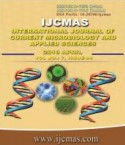


 National Academy of Agricultural Sciences (NAAS)
National Academy of Agricultural Sciences (NAAS)

|
PRINT ISSN : 2319-7692
Online ISSN : 2319-7706 Issues : 12 per year Publisher : Excellent Publishers Email : editorijcmas@gmail.com / submit@ijcmas.com Editor-in-chief: Dr.M.Prakash Index Copernicus ICV 2018: 95.39 NAAS RATING 2020: 5.38 |
The citrus psyllid, Diaphorina citri Kuwayama, is the most important pest of citrus worldwide because it serves as a vector of Candidatus Liberibacter species that cause citrus greening disease. The nymphs and adults suck cell sap causing curling of leaves, defoliation, flower drop and death of branches from t to downwards which is known as die back. The peak population found usually in March-April and August-September. Among the parasitoid, Tamarixia radiata is promising and needs to be introduced and chemical control is the primary management strategy currently employed, but recently documented decreases in susceptibility of D. citri to several insecticides illustrate the need for more sustainable tools. Herein, we discuss recent advances in the understanding of D. citri seasonal abundance and behavior, pathogen transmission biology, biological control, and chemical control goal is to point toward integrated and biologically relevant management of this insect-pest.
 |
 |
 |
 |
 |